Stone Identification: Reading What You Find
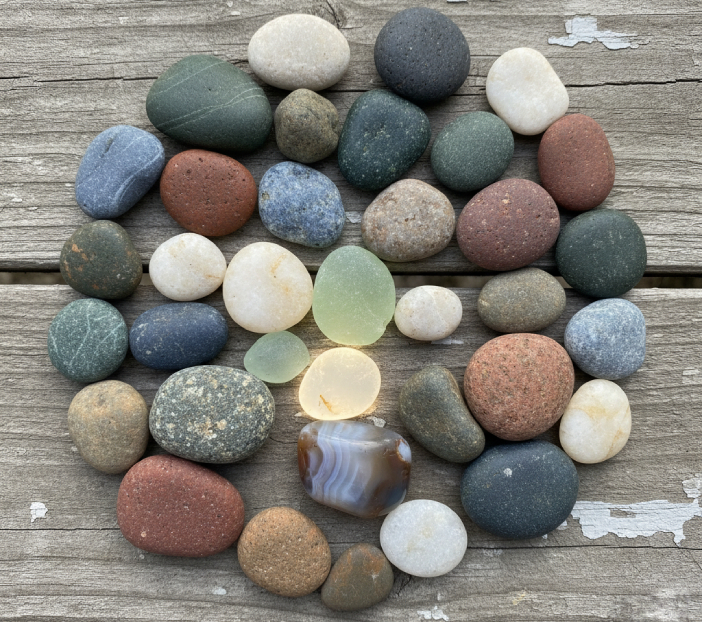
Most lapidary books start with the assumption you're buying labeled rough from a dealer. Jasper arrives as jasper. Agate comes marked as agate. But half the stones in any home lapidary collection came from somewhere else. A riverbed. A hiking trail. That weird rock your kid found that's been sitting on your desk for three months.
Suddenly you're holding something that could be jasper, chert, chalcedony, flint, or any of fifty other cryptocrystalline varieties of quartz that all look suspiciously similar to the untrained eye. Or it could be calcite. Or dolomite. Or some sedimentary rock that won't survive the first pass on a grinding wheel.
The identification process lapidaries actually use looks nothing like the mineral identification keys in geology textbooks. Those assume you have a proper sample, a testing kit, and enough patience to work through dichotomous keys. Real stone identification in a workshop setting relies on faster indicators.
Hardness Testing Without a Lab
The Mohs hardness scale exists in every lapidary reference book. Talc at 1, diamond at 10, quartz at 7. What the textbooks skip over: what this actually feels like when you're testing an unknown stone.
 The Mohs hardness scale. Image: Kilawyn Punx, CC BY-SA 4.0, via Wikimedia Commons
The Mohs hardness scale. Image: Kilawyn Punx, CC BY-SA 4.0, via Wikimedia Commons
A steel file sits around 6.5 on the Mohs scale. Run it across quartz (hardness 7) and the file skates across the surface without catching. The stone is harder than the file. Run the same file across calcite (hardness 3) and it bites in, leaving a scratch and producing powder. The file is harder than the stone.
This single test eliminates huge categories of possibilities. Anything harder than steel falls into a relatively small group of minerals. Quartz and its varieties (jasper, agate, chalcedony, flint, chert). Beryl. Topaz. Corundum. The common gemstones.
Anything softer than steel opens up to the calcites, the fluorites, the alabasters. Materials that look appealing but present different challenges on lapidary equipment. Many experienced cutters won't touch calcite-family stones without specific tooling because the material gums up diamond grinding wheels designed for harder substances. Different materials require different approaches to grit progression during the polishing process.
The fingernail test works at the other end of the scale. Human fingernails sit around 2-2.5 on Mohs. A fingernail that leaves a visible scratch means you're holding talc, gypsum, or something equally soft. These materials rarely make it to the cutting stage unless someone specifically wants to work with them.
A pocket knife blade (hardness 5-5.5) sits between the fingernail and the file. It scratches calcite and fluorite but not quartz. Three simple tools, three hardness checkpoints, covering most of what lapidaries encounter in practice.
The limitation here: hardness testing destroys aesthetics. That scratch from your pocket knife stays visible. Most cutters test in spots that'll be trimmed away during initial shaping, or on a broken edge if the stone comes pre-fractured.
Pattern Recognition in Cryptocrystalline Quartz
Here's where identification gets weird. Jasper, agate, chalcedony, flint, and chert are all the same mineral. Silicon dioxide. SiO₂. Quartz. The differences come down to crystal structure (microscopic versus crystalline), impurities (iron oxide for red, manganese for pink), and formation conditions.
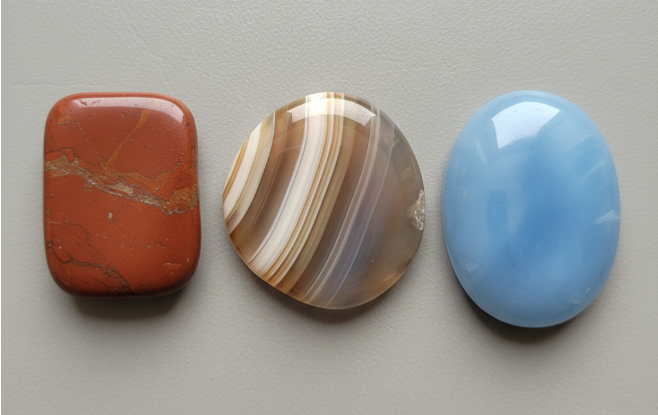 Visual comparison showing the opacity differences between jasper (left), banded agate (center), and translucent chalcedony (right)
Visual comparison showing the opacity differences between jasper (left), banded agate (center), and translucent chalcedony (right)
Lapidaries working with these materials develop a visual vocabulary that has nothing to do with chemistry.
Jasper reads as opaque and earthy. Hold it up to a bright light and nothing passes through, even at thin edges. The coloring tends toward reds, browns, yellows, greens. The patterns, when present, look painterly. Swirls and clouds rather than geometric precision.
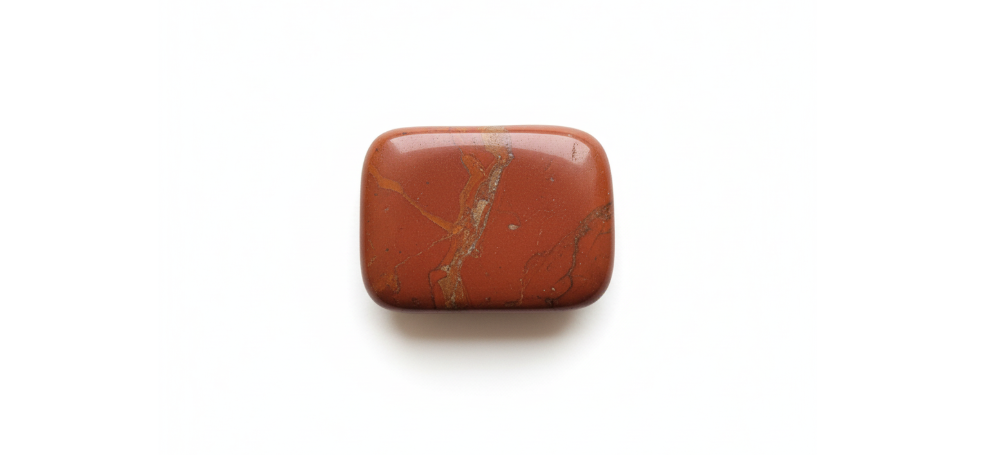 Jasper showing characteristic opaque, earthy appearance with painterly color patterns
Jasper showing characteristic opaque, earthy appearance with painterly color patterns
Agate shows translucency and banding. Even thick pieces let some light through at the edges. The bands run in parallel layers, sometimes straight, often curved, occasionally creating fortification patterns that look like topographic maps. The coloring varies wildly but the banding stays consistent.
_(32734668126).jpg) Agate from Malawi showing characteristic banding patterns. Image: James St. John, CC BY 2.0, via Wikimedia Commons
Agate from Malawi showing characteristic banding patterns. Image: James St. John, CC BY 2.0, via Wikimedia Commons
Chalcedony appears waxy and translucent without banding. It's what agate looks like if you remove the patterns. Sometimes chalcedony shows color zoning, gradual shifts from one shade to another, but without the sharp boundaries that define agate bands.
Chert and flint occupy the same practical category. Both are opaque like jasper but with a different texture quality. More uniform. Less painterly. Chert tends toward grays and tans. Flint runs darker, often black or dark gray. Both fracture with sharp edges, a characteristic that made them useful for tools before metal became widely available.
The visual differences matter because they predict how the stone will behave during cutting. Agate's banding means you can orient the stone to feature or minimize those patterns. Jasper's opacity means you're working with surface color only. Chalcedony's translucency creates different options for cabochon cutting where light transmission affects final appearance.
Setting up a proper lapidary workshop requires understanding which stones you'll primarily work with, since different materials have different cutting and polishing requirements.
Obsidian occupies its own category despite being volcanic glass rather than crystalline quartz. It looks like black glass because that's essentially what it is. The conchoidal fracture pattern (covered next) presents clearly in obsidian. It's also surprisingly soft for something that looks so glassy, usually sitting around 5-5.5 on Mohs rather than the 7 you'd get with crystalline quartz.
Fracture Patterns and What They Reveal
Drop a piece of quartz on concrete and it breaks into pieces with curved, shell-like surfaces. This is conchoidal fracture, and it's diagnostic for certain mineral groups. Quartz does it. Obsidian does it. Glass does it.
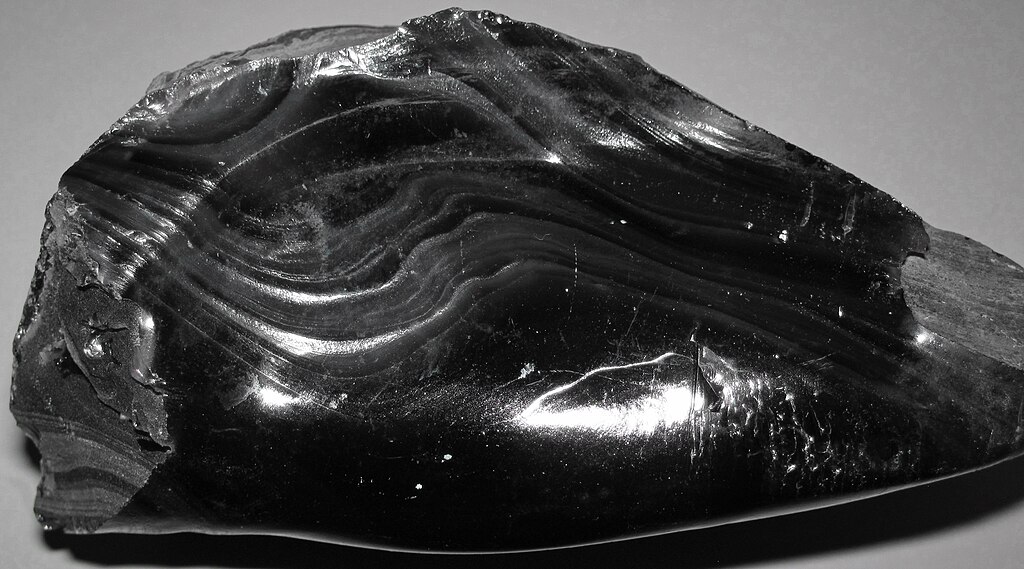 Obsidian displaying classic conchoidal fracture with curved, shell-like surfaces. Image: James St. John, CC BY 2.0, via Wikimedia Commons
Obsidian displaying classic conchoidal fracture with curved, shell-like surfaces. Image: James St. John, CC BY 2.0, via Wikimedia Commons
Calcite breaks differently. The fracture follows the crystal structure, creating flat planes that reflect light at specific angles. This is cleavage, and it tells you immediately you're not working with quartz.
Granite shatters into irregular chunks without the smooth curved surfaces of conchoidal fracture or the geometric planes of cleavage. It's a rock made of multiple minerals, so it fractures along the boundaries between those minerals. This type of fracture means the material won't polish uniformly.
These fracture patterns show up even on found stones that aren't freshly broken. Look at the edges. Natural weathering and erosion create broken surfaces over time. A stone sitting in a riverbed for decades has edges that reveal how it breaks.
Conchoidal fracture produces edges that curve smoothly, sometimes with fine ripples radiating from the point of impact. Cleavage creates edges that meet at distinct angles with flat faces. Granular fracture shows rough, uneven surfaces where different minerals separated from each other.
This matters more than identification alone. The way a stone breaks predicts how it will respond to lapidary grinding wheels. Materials with conchoidal fracture can be shaped predictably. Aim the grinding wheel at a specific angle and the stone removes in controlled amounts. Materials with strong cleavage risk splitting along those natural planes. Granular materials may pull apart at mineral boundaries rather than grinding smoothly.
Understanding these fracture characteristics helps when selecting stones for specific lapidary saw blade operations.
Field Context and Geological Indicators
A translucent red stone found in a riverbed in Oregon has different probability than the same-looking stone found in a Texas desert. Geological context eliminates possibilities before you touch a testing tool.
Agates form in volcanic rock, filling gas bubbles left as lava cooled. Find one in a riverbed and it likely weathered out of volcanic formations upstream. But rivers carry stones for miles, sometimes through multiple geological zones. The context suggests what to test for but doesn't confirm identity.
Jasper forms in sedimentary environments, often replacing organic material or forming from silica-rich sediments. Find it in areas with sedimentary rock formations. But again, erosion and transport muddy the picture.
Limestone regions produce calcite and dolomite. Granite regions produce quartz. Metamorphic zones create interesting variations where heat and pressure have altered original minerals into something else entirely.
The shape provides clues too. River stones get rounded from tumbling. Angular stones with sharp edges haven't been transported far from their origin point. Beach stones show specific wear patterns from wave action. Desert stones might have wind-polished surfaces.
One specific indicator: if you find a stone in a location known for specific gem material, test it against those expectations first. Montana sapphire country probably means you're holding something sapphire-adjacent. Oregon sunstone regions make sunstone more likely. This isn't identification but probability assessment.
Visual Markers Experienced Cutters Use
Walk into a lapidary workshop and show an experienced cutter an unknown stone. They'll often identify it within seconds without touching a testing tool. This isn't magic, it's pattern recognition built over years of handling specific materials.
Petrified wood shows growth rings and cellular structure. Even when fully replaced with silica, the wood grain patterns remain visible. Sometimes bark texture survives on the exterior. No other stone produces these organic patterns.
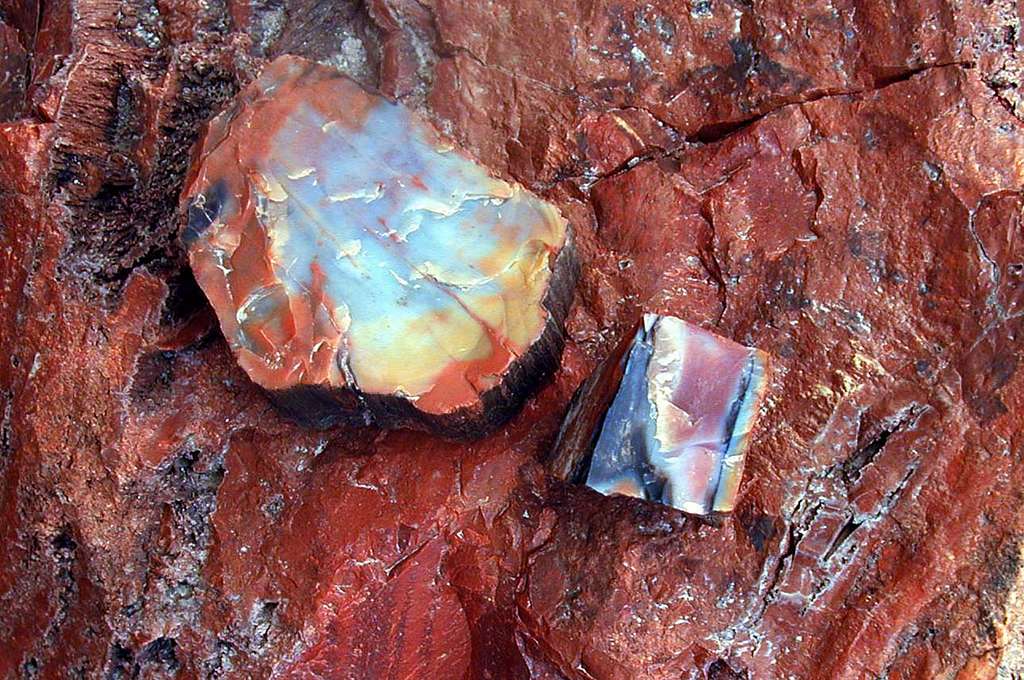 Petrified wood with visible growth rings and cellular structure preserved in silica
Petrified wood with visible growth rings and cellular structure preserved in silica
Turquoise has a specific blue-green color range and often shows matrix (the host rock it formed in) as darker veining. It's also softer than quartz, sitting around 5-6 on Mohs. A stone claiming to be turquoise that tests harder than steel probably isn't turquoise.
Malachite creates distinctive green banding in concentric circles. It's a copper carbonate mineral, significantly softer than quartz. Real malachite leaves green marks if you rub it on unglazed porcelain. It also reacts with acids, fizzing slightly if you put a drop of vinegar on it (a destructive test reserved for stones you're willing to mark).
Tiger's eye shows parallel fibers of color, usually golden to reddish-brown, with a silky luster. It's a variety of quartz that formed by replacing fibrous crocidolite. The fiber alignment creates chatoyancy, a light effect that moves across the surface as you rotate the stone.
Lace agate from Mexico has specific pattern characteristics different from Montana agate or Lake Superior agate. The differences are subtle but consistent. Geographic origin affects the visual markers because local formation conditions varied.
Some stones resist identification by eye entirely. A piece of white chalcedony looks identical to white quartzite looks identical to certain types of marble, at least until you start testing hardness or checking fracture patterns.
The Limitations of Field Identification
A professional gemological lab can tell you definitively what stone you're holding using specific gravity tests, refractive index measurements, and spectroscopy. These tools measure physical properties that don't overlap between different minerals.
In a home workshop with hand tools, identification becomes probabilistic rather than definitive. You're making educated assessments based on the indicators available.
Two stones can look identical but have different identities. Green jasper and green aventurine appear similar until you examine them closely under magnification. Aventurine contains small mica inclusions that create sparkle. Jasper lacks those inclusions. But from three feet away, they look alike.
Some stones deliberately confuse identification. Moss agate isn't agate at all in the traditional banded sense. It's clear to translucent chalcedony with dendritic inclusions that look like moss or ferns. The name stuck despite the technical inaccuracy.
Commercial names compound the confusion. "Onyx" in the marble industry means a different stone than onyx in the gemstone world. Mexican onyx is calcite. Gemological onyx is a black variety of chalcedony. Same name, completely different minerals with different hardness levels.
Treated stones create another identification category. Much of the bright blue turquoise on the market has been stabilized with resin to improve durability. The treatment changes how the stone responds to testing. Natural turquoise might show porosity if you put a water drop on it. Stabilized turquoise doesn't absorb water because the pores are filled with resin.
Dyed stones present even trickier identification challenges. Howlite (a white stone with gray veining) is commonly dyed bright blue to simulate turquoise. The hardness test reveals the difference (howlite sits around 3.5 on Mohs, softer than turquoise), but the visual similarity has confused plenty of buyers.
When Visual Assessment Isn't Enough
Some stones require proper testing beyond what a home workshop provides. If you're planning to sell finished pieces and claim specific stone identities, accuracy matters for customer expectations and fair trade practices.
Synthetic materials complicate identification further. Lab-created stones have the same chemical composition and crystal structure as natural stones. A synthetic ruby is still corundum. It just formed in a controlled environment rather than in the earth. Visual identification can't distinguish synthetic from natural in many cases.
Simulants add another layer. Cubic zirconia simulates diamond but has a completely different chemical composition. Glass can simulate almost any colored stone. These require testing beyond visual examination.
Professional gemological services cost money but provide certainty. For stones of questionable identity but potential value, the testing fee might be worth avoiding expensive mistakes. A stone you thought was jade but turns out to be serpentine affects pricing if you're selling finished work.
For personal collection pieces where you're cutting for your own interest rather than commercial sale, field identification provides enough information to work with. Knowing whether something is harder or softer than steel determines which grinding wheels to use. Knowing whether it's translucent or opaque affects design decisions for cabochon shapes.
The identification process becomes familiar with practice. The first hundred unknown stones take careful testing and conservative assumptions. After working with enough material, the visual indicators start making sense. The way light interacts with chalcedony versus jasper becomes obvious. The texture difference between chert and basalt shows up immediately.
But even experienced lapidaries occasionally misidentify material, particularly when working with unusual finds from unfamiliar locations. The humility of not knowing exactly what you're holding until you test it keeps the process honest.